Travelsim E-sim mobile application
Client
TravelSim by Top Connect
duration
January 2020 - May 2020
Design challenge
How might the recharging process be optimised for TravelSIM card abroad?
Responsibility area
UX & Strategy, Business Design, Creative Project Management. UI design by the wonderful Laura
business value proposition
TravelSIM gives frequent travellers an opportunity to save up to 80% on their roaming fees with SIM cards that work in a wide range of countries. They offer both virtual (eSIM) and physical SIM cards.
process, methods & tools
As UX consultant of this project, I looked at the business globally. From the value proposition and business model, through target audience and personas, all the way to user flows, the screens, and the UI plus the content and copy showcased. I went through the four stages design thinking process: Discover, Define, Design, Deliver. Using different tools to facilitate strategic thinking, research, user journeys, personas, purchase concept and supported artefact delivery.
Tools used: Roadmap planner, user journey canvas, value proposition, competitor and business design map
This was a project with a fully remote team, which allowed us to work with an efficient pace, even during the challenging pandemic time.
For project management I used Confluence collaborative workspace. Making a project overview including all the stakeholders, OKRs, a visual timeline, milestones and deadlines, helped all the parts involved stay up-to-date. A useful feature is to create action items and tag the responsible with a deadline for the specific task. It kept us all in track with a transparent workflow.
For remote usability testing, I tried a new tool called Lookback where I was able to share the full test, and everything is recorded, including behavior on screen. It was a great testing hub, as I could skip having videos laying around my desktop and polluting the process.
We used Toggl timer for tracking our working hours, both to have an overview of what to charge to our client, and also to use as data for improving our team performance.
“Easy to use, really like the intuitive recharging feature”
challenges and learnings
Working during the Covid-19 pandemic certainly proved challenging. Despite the difficulties, working remotely and keeping a positive attitude gave us all hope and motivation to keep working. Also, it was crucial to have one in person team meeting, to be able to connect and build trust.
Another challenge I faced, was being able to insist on a clear delivery deal at project start, where every part is highly engaged and excited. There tends to be made requests and promises that can’t possibly be delivered. The lesson I distilled is to use the necessary time for full clarity of delivery before contract signage.
Our client was very experienced and made it easy to avoid multiple stakeholder involvement, which is usually the main cause of projects delaying. Out of previous experiences I learned to keep it simple and to the point with stakeholder communication. No hidden agendas! With that said, there was a little delay towards the end of the project, however it did not cause any damage to the full delivery.
With a virtual handshake and a happy client, I look forward to seeing this app come alive, despite the critical timing of the travel industry. Like the client puts it: “The real design work, starts when the product is released.”


